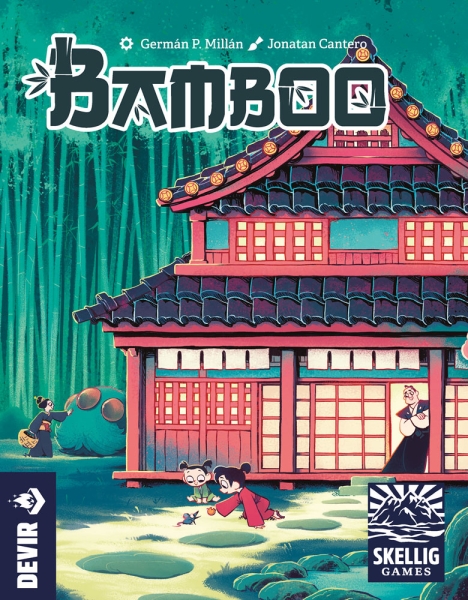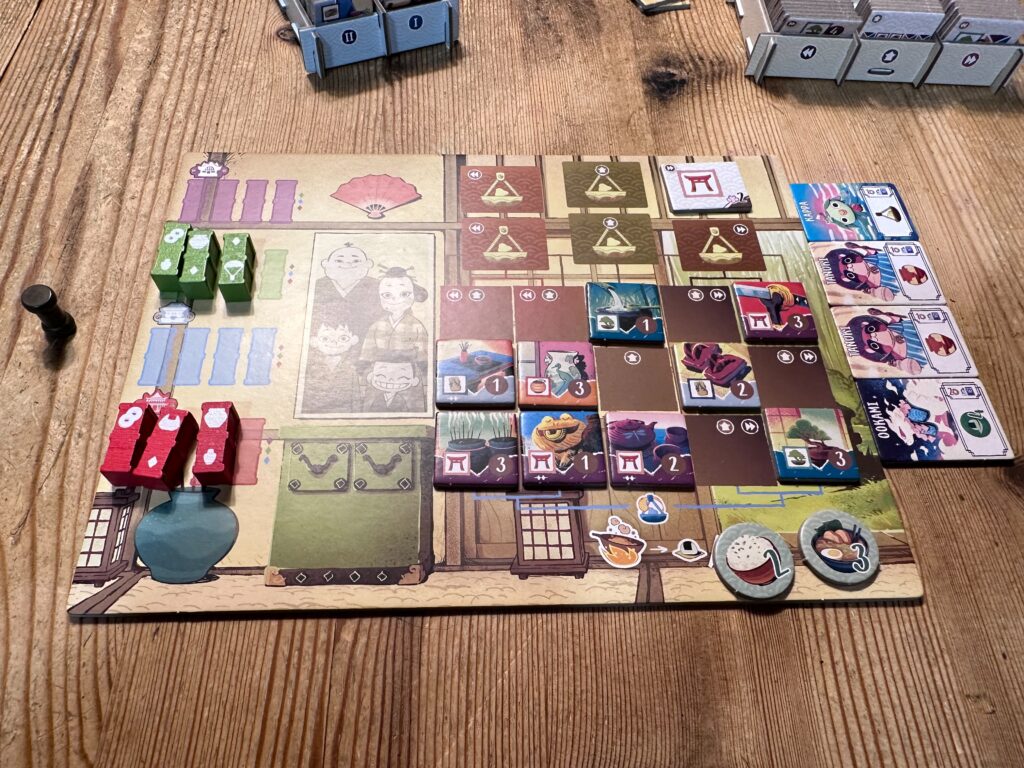
In backgammon Bamboo We try to develop our home in a harmonious balance. Offerings must be made to appease the ancestors and spirits.
Now the game from Devir Games is published by Skellig Games.
Game description
in Bamboo In addition to the central game board, we have our own little house map in front of us. At the start of the game, we receive three incense sticks in our colors and six bamboo stones in the four temple colors. One of four possible actions appears on the action stones.
We play over four rounds in four seasons:
- Spring: We get an extra incense stick in each of the four rounds, so we have seven in the final round. There is also a Gift of the Forest (corresponding to the four actions) that we can play in the summer.
- Summer: We take turns visiting the temple and placing incense sticks, which correspond to the number of bamboo stones (same color as the temple). If the number of incense sticks is less than the number of working stones, we are allowed to perform a maximum of x actions (=number of incense sticks).
1. We take two coins
2. We take the food tile (value 1-3)
3. We improve our house and pay 1-3 money for the corresponding tiles
4. We perform two balancing actions where we take a set of 0-2 quest tiles or complete/activate 0-2 quests in our house (to get victory points). To-do boxes are assigned to specific areas in our home. - Autumn: We evaluate the temples: majority evaluation of incense sticks and distribution of youkai tiles (gives us a one-time advantage in the game that is then exploited)
- Winter: We can unscrew the Youkai tiles again to get money and we have to feed our family (every less food is a minus point)
The game ends after four rounds and we award victory points for quests that were not activated but were completed. For each different Yokai tile and for each glitch on the left and right halves of the house, there are still two points missing.
In a two-player game, it is the ghost player's turn.

Author: Germain B. Milan ■ Chart: Jonathan Cantero
Publisher: Devir|Skellig Games ■ Release year: 2024




2-4 players


14 years and above


About 90-110 minutes
Game rules (External link to Skellig Games)


Gaming feeling
I have to admit that before the first game, I had difficulty understanding Bamboo and handling the instructions. The board game is not difficult to understand and play, as we follow a strict sequence of four rounds, which is also marked on the central game board.
Although it has nice graphics, some of my fellow players had issues with the numerous symbols on the game boards and tiles, especially in the early games. But that disappeared after the second match at the latest.
Enjoyable downtime
The moves themselves play out relatively quickly, so downtime is pleasantly short even when the game is full (well, with intense thought, a lot of things get boring). The number of players who play Bamboo varies. The fewer design options you have, the more activity you have with tiles. When the game fills up, it helps that the displays (quests, decorations, bamboo) change dramatically in the meantime, so that you can sometimes use much better alternatives for yourself.
The only issue that can be an issue is food if the three desired tiles are grazed at the beginning of the round and then “only” the first tiles end up on the screen.
Some interactions in the game
In addition to displaying various tiles, the “battle” for temples and youkai tiles is very exciting in every round. Also, being able to flip one coin per stick gives you a surefire, albeit costly, effect in securing a majority in the temple.
Yokai tiles should not be underestimated, as they may eventually bring victory points and additional options to act or influence the course of the game. But there are only four available in the game. Which can be a bit difficult, especially in four-player matches.
Timing is important
As the presentation has changed, Bamboo, in my view, is more of a tactical game than a strategy game. However, there is a strategic element that comes into play by choosing bamboo stones. Here we can – assuming appropriate width – prepare the next and following moves partly by our choice, where we must keep the different options open to us so that we can interact by choosing colors and symbols.
Naturally, the game thrives on good combinations of quests and home improvement tiles. It is always important to keep your eyes open for the view. Anyone with good comprehension skills here is definitely at an advantage when it comes to recognizing opportunities available to them.
If the rules are understood well, Bamboo will play very quickly starting from the second game at the latest and we have already managed to stay for less than 90 minutes. Even if we do roughly the same thing in every game, the games play differently because of the variety of presentation.
Suboptimal storage
What I'm still not sure about is the idea of cardboard boxes for storing tiles. On the one hand, the box cannot be closed properly, and on the other hand, at the end of the game, the small tiles keep flipping over so that they have to be painstakingly taken out of storage. Well intentioned, but not fully implemented. Not for people with big fingers.
Maintain balance
Especially in the first game, it may happen that you don't keep your balance at the end. This is a tricky extra, so don't just start building at home.




summary
Bamboo does a lot of things right. Starting from the second game at the latest, it is a quick game to play with tactical and strategic elements with a fun bit of game board interaction, and one that I will play again and again.
For me, some things are so detailed in terms of textures and graphics, that a little bit of the fun of the game is lost. I also find the story to be very artificial and I can only understand it to a very limited extent.






- An interesting selection mechanism through bamboo stones, where we are also preparing future rounds.
- Numerous panels lead to a certain degree of variation despite the standardized process
- Fun interaction in the game.
- Understandably, bamboo plays a short playing time and is very enjoyable for the game connoisseur.


- The theme seems too artificial to me (including the house and feed tiles).
- The game material is very small. The symbolism is good, but not easy to recognize for every player.
- The games are similar in terms of operation (see plus)


From my point of view as a player: A connoisseur's game that wants to achieve taste through the story, but in my opinion it doesn't manage to do so because the story feels too artificial. Leaving that aside, we have a board game with fun short actions in which we optimize our game board (the house at the bottom) so that the task squares fit well on it and vice versa. Including choosing bamboo stones, it is important to plan ahead a little.



“Explorer. Communicator. Music geek. Web buff. Social media nerd. Food fanatic.”





More Stories
Who is the band Gojira that will perform at the Olympics opening ceremony?
SpaceX Moves Crew Dragon Spacecraft to West Coast After Multiple Space Debris Incidents
Stathis Karapanos – Hindemith Review: Complete Works for Flute